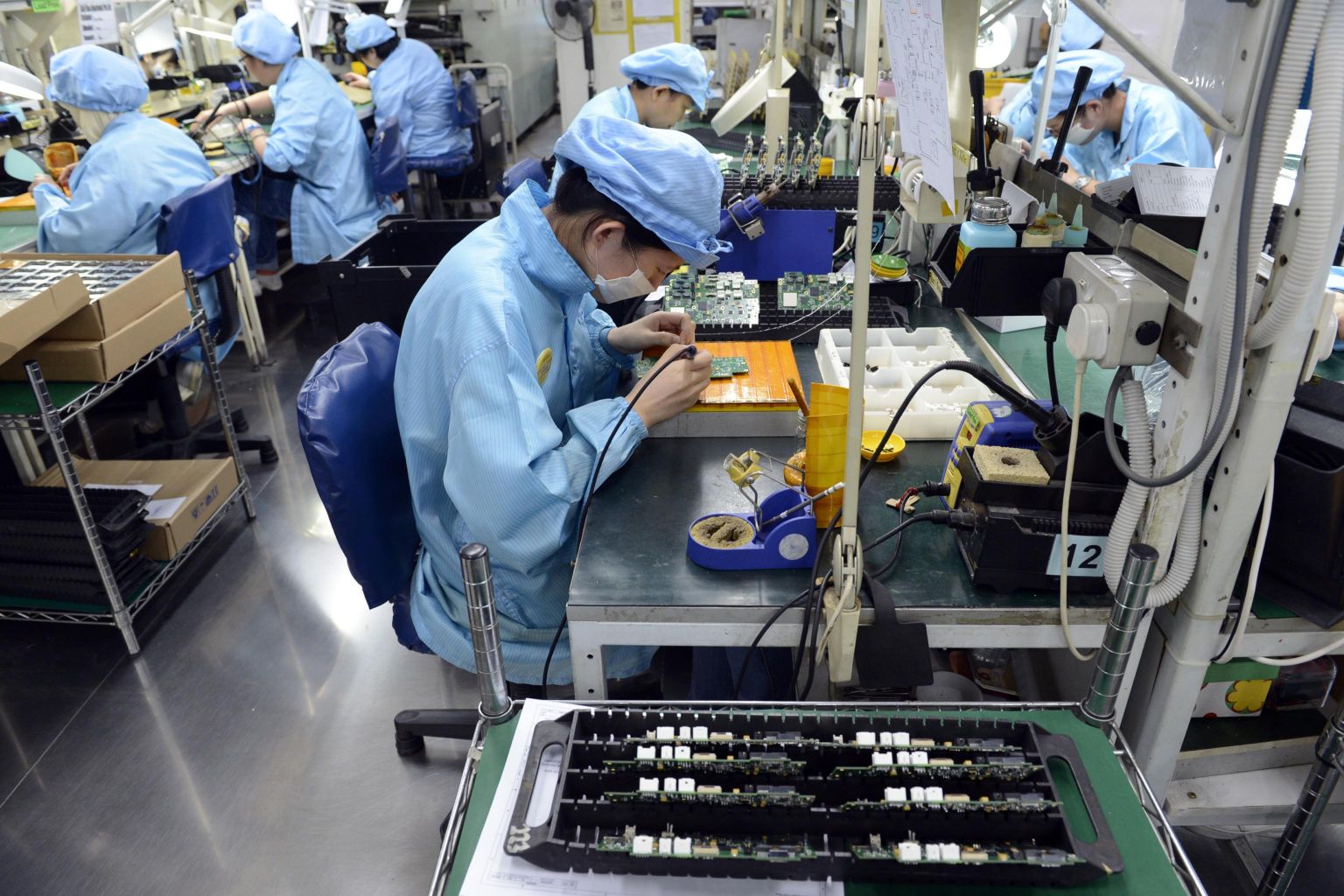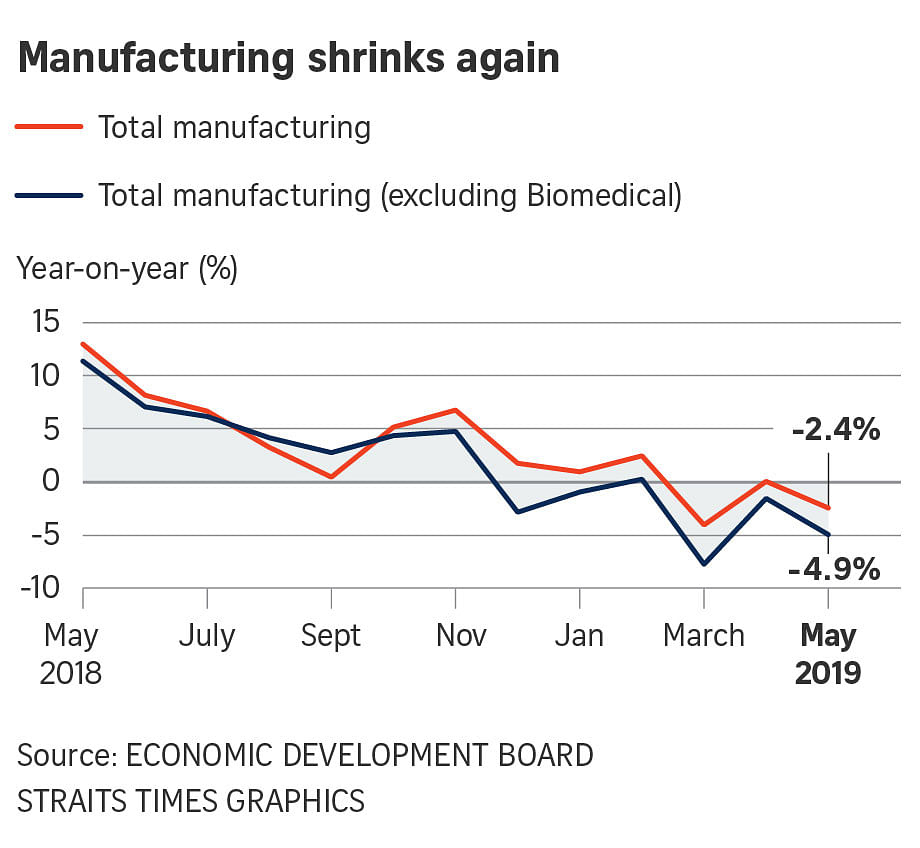Singapore factory output falls 2.4% in May, worse than expected
Sign up now: Get ST's newsletters delivered to your inbox

Factory output fell 2.4 per cent in May compared with the same period last year.
PHOTO: ST FILE
Follow topic:
SINGAPORE - Singapore's manufacturing output turned negative again last month, after a brief uptick of 0.1 per cent in April, led by a 10.8 per cent slide in the key electronics sector.
Factory output fell 2.4 per cent in May compared with the same period last year, according to figures released by the Economic Development Board (EDB) on Wednesday (June 26).
This was worse than the 1.8 per cent decline forecast by analysts in a poll by Bloomberg. But it was not as bad as the 4 per cent fall in March, which had been the sector's first contraction in more than a year.
If the volatile biomedical manufacturing is excluded, the fall in May was a steeper 4.9 per cent.
Observers put the poor showing down to the trade war between the United States and China.
SIM Global Education senior lecturer Tan Khay Boon said the trade dispute shows no sign of abatement "and the effect has changed from a negative sentiment to an actual decline in manufacturing demand".
Maybank Kim Eng economists Chua Hak Bin and Lee Ju Ye said they expect the manufacturing sector to remain in contraction this month (June). "Disruptions to the supply chain will likely intensify as the trade war broadens to tech and the US imposes export controls on more Chinese tech firms," they said.
Dr Tan noted that Singapore manufacturers are part of the global supply chain for electronics components.

The decline last month was led by the electronics cluster, which makes up over a quarter of the whole manufacturing sector. Electronics output contracted by 10.8 per cent year-on-year, with semiconductors, computer peripherals and data storage posting falls.
Comparing the first five months of this year with the same period last year, electronics production was down 4.5 per cent.
Output from biomedical manufacturing grew by 8.8 per cent in May. Within the cluster, pharmaceuticals output expanded 15.9 per cent, while medical technology output fell 6.8 per cent due to lower export demand for medical devices.
Comparing the first five months of this year with the same period last year, biomedical manufacturing production was up 10.7 per cent.
The precision engineering cluster saw output dip by 4.7 per cent in May. It was a mixed bag with precision modules and components rising 17.1 per cent due to higher production of optical and plastic precision products, while machinery and systems declined 16.6 per cent with lower output in refrigeration systems, process control equipment and semiconductor-related equipment. Comparing the first five months of this year with the same period last year, precision engineering production was 10.4 per cent lower.
Chemicals output also slipped by 0.4 per cent, mainly due to the 9.5 per cent decline in petrochemicals output. This was largely due to maintenance shutdowns in some plants, said EDB. Comparing the first five months of this year with the same period last year, chemicals production was down 0.4 per cent.
In transport engineering, output grew 2.9 per cent. The aerospace segment grew 17.2 per cent on the back of more repair and maintenance jobs from commercial airlines. But lower levels of offshore and shipbuilding and repairing activities saw the marine and offshore engineering segment decline by 10.9 per cent. Comparing the first five months of this year with the same period last year, transport engineering production was 2.9 per cent higher.
Finally, general manufacturing output was up 4.9 per cent, led by the food, beverages and tobacco segment which posted growth of 9.3 per cent due to more beverage products being produced.
Comparing the first five months of this year with the same period last year, general manufacturing production was up 3.4 per cent.
On a seasonally-adjusted basis, factory output slipped 0.7 per cent in May compared with April. Excluding biomedical manufacturing, the decline was 2.6 per cent.
On a seasonally-adjusted basis, factory output slipped 0.7 per cent in May compared with April. Excluding biomedical manufacturing, the decline was 2.6 per cent.
In transport engineering, output grew 2.9 per cent. The aerospace segment grew 17.2 per cent on the back of more repair and maintenance jobs from commercial airlines. But lower levels of offshore and shipbuilding and repairing activities saw the marine and offshore engineering segment decline by 10.9 per cent.
Finally, general manufacturing output was up 4.9 per cent, led by the food, beverages and tobacco segment which posted growth of 9.3 per cent due to more beverage products being produced.

